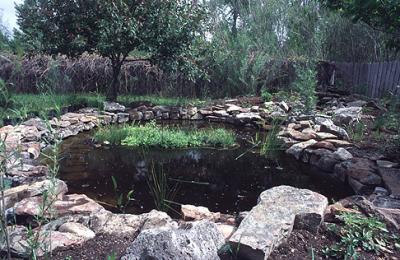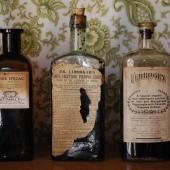Bio-Havens
As a kid in northern Wisconsin, Bruce Kania loved to mess around outdoors hunting, fishing and trapping. The wild, floating islands that rafted near the edges of lakes he haunted particularly captured his imagination. As it turns out, Kania’s imagination was a big creature to capture. The boy grew up to invent and produce an intriguing list of products ranging from a medical prosthetics liner to a motion reconciliation device designed to counteract seasickness. Now, with the support and expertise of a diverse team of players, Kania has created his own floating islands.
The motivating force behind Kania’s inventions comes from a desire to enhance quality of life—whether it’s the life of an amputee or a blue-winged teal. Kania’s islands, known as BioHaven Wild Floating Islands (produced by parent company Floating Island International), provide habitat for a myriad of fish and wildlife species and employ special microbes to improve water quality in the surrounding environment.

Most good ideas grow out of some need or problem, and in this case, the problem was predators. Foxes, mink, and other hungry carnivores were decimating the ground-nesting birds on Kania’s farm in Shepherd, Montana. With a mile of Yellowstone riverfront, fourteen springs, two streams, and two ponds on the property, Kania began to think about making his own islands to provide sanctuary for the birds. Remembering the floating islands (also called “floating bogs”) of his youth, the inventor started inventing.
Part of Kania’s success in inventing and producing new products comes from his willingness to seek out other inquiring minds. First, Kania turned to Frank Stewart, a civil engineer specializing in hydrology. Stewart had already dedicated over ten years to pond, stream and water design and immediately saw potential in the project.
”For years I had been observing that fish and waterfowl are attracted to islands for food and security,” Stewart explained, “and I had also been learning about the value of wetland plants for treating water quality problems. When Bruce showed me a small floating island that was experiencing very rapid growth compared to plants growing along the shore, I got excited about the potential for producing a floating island project that would have multiple benefits for pond owners.”
As design ideas emerged, Kania and Stewart enlisted Thomas Coleman and Russell Smith of Aquatic Design Construction Services, Inc. (ADC Services). Coleman, an environmental engineer, and Smith, who has a degree in environmental conservation, have designed and implemented sustainable and diverse restoration projects throughout Montana, including restorations of stream and river systems, lake and pond habitats, wetlands, and associated uplands. ADC takes a multidisciplinary approach to restoration that includes engineering, fisheries biology, ecology, hydrology, geomorphology, sediment transport and landscape design. ADC also operates a native plant and wetland nursery on the Yellowstone River to supply plants for their projects and the projects of private consumers and public agencies. With their extensive experience building ponds that conserved water and provided an environment in which fish could thrive, ADC offered the horticultural and biological knowledge crucial to developing the floating island design.
Using materials scavenged from other projects, the team began building island prototypes. Through trial and error, with various degrees of success, the islands literally materialized.
The team settled on a recycled polymer matrix for the main construction material. The filter-like batting provides both structure and growing surface and creates a nearly neutrally buoyant, natural-looking island, easily customized and able to withstand the elements. The polymer matrix is also a perfect living environment for microbes, which are crucial to the success of the team’s vision of the role floating islands can play in improving water quality.
The uptake of nutrients in a body of water became a key element in the floating island project. Algae growth is a major factor in water clarity and overall aquatic health. Excess algal growth contributes to the slow degradation or eutrophication of bodies of water. Eutrophication is a process in which lakes become increasingly saturated with dissolved nutrients such as phosphates, which can come from a variety of sources ranging from fertilizers to animal waste. These dissolved nutrients stimulate algal growth, which in turn can deplete the water’s oxygen and also block sunlight. Eutrophication can lead to fish kills and can ultimately kill the body of water itself. Copper-based products are available to break down algae, but copper can be harmful to aquatic plants and animals at certain levels.
For help with the nutrient challenge, the team turned to Al Cunningham and Jim Keeton. Cunningham, a professor of civil engineering at Montana State University, specializes in aquatic microorganisms, including bacteria. Keeton, of Keeton Industries in Fort Collins, Colorado, has 30 years of experience in public and private water treatment systems, both in the United States and abroad.
Keeton developed a way to use special phosphate-eating microbes to counteract the eutrophication process. In order to affect this highly scientific solution, Keeton takes the low-tech approach of tossing a water soluble bag of microbes into the pond so it bumps up against the island. Microbes prefer attaching themselves to things (like the shoreline or plant roots) rather than drifting around, and a floating island offers the perfect opportunity for settlement. This essentially turns the island into a giant water filter. As water flows through the porous island matrix, the colony of microbes is at the ready to remove phosphates. The nature of the polymer matrix material creates an enormous amount of surface area, even on small islands. Floating Island International estimates that one island can quintuple the habitat available for beneficial microbes.
As Smith describes it, there’s a “symbiotic relationship between the plants and these microbes.” Plants and microbes grow in conjunction and take up nutrients which in turn become less available to undesirable organisms like algae. “That’s one of the big thrusts of the project,” says Smith—to consider the islands “not only as an aesthetic platform, but also as a way to incorporate beneficial microbes and utilize the natural ability of plants to uptake nutrients.”
Root growth is the other major component in aquatic health. Elaborating on his partner’s statement, Coleman continues, “A major part of the water treatment component is the root system of aquatic plants. The matrix of the island is a porous medium that the roots will grow through, extending below the island. You have a lot of contact between the water and a massive amount of roots for uptake of nutrients.”
Roots growing down into the water also provide shade, safety, and cover for fish even while they’re helping to control algae growth. The team has seen fish congregate under their test islands.
Planting options for the island are diverse, and the team at Floating Island International offers recommendations based on the size, purpose and location of an island. In a controlled environment such as a backyard, a homeowner may opt for nonnative ornamental species. A golf course landscaper might choose species with optimal nutrient uptake, while a conservation organization might select species with fish and waterfowl habitat in mind.
Though Floating Island International will customize an island and provide the plants, buyers may also purchase a “blank” island with pre-dug pockets, then choose their own plants from local nurseries. Islands can also be directly seeded using current hydro-mulching technology. Species selection can then be refined to produce an island with more even growth.
Designed with the buyer in mind, the lightweight matrix of the island allows a homeowner to easily position it. Once in place, maintenance is minimal. Islands can be replanted if desired, but with the careful initial selection of plants, islands will thrive with little attention. Given their ready access to water, island plants can grow at several times the rate of their shoreline counterparts. In the natural, seasonal cycle of plant growth and die-off, young islands especially may become higher and more dense over time. BioHaven Wild Floating Islands are adjustably buoyant to compensate for weight fluctuations.
Though the initial floating island prototype is ready for market, the team has no intention of stopping the design process. Floating Island International is currently designing research in conjunction with Delta Waterfowl, a 90-year-old research organization founded by Aldo Leopold. Delta Waterfowl is North America’s leader in waterfowl ecology and waterfowling. The goal of this collaboration is to design inexpensive, predator resistant floating islands. The two organizations plan to work together in the near future toward this end. A BioHaven predator-resistant Wild Floating Island is targeted for market within two years.
As Stewart says, “It seems that almost every pond owner sees room for improvement in their pond—whether it’s improving water clarity, growing more and bigger fish, creating lush and diverse vegetation, or providing waterfowl nesting habitat. We believe our floating islands offer a fast, cost-effective method for making ponds more attractive to people and valuable to wildlife.”
Floating Island International has already tested an island that can support the weight of five men, and islands of varying sizes can be linked to further expand the possibilities. The team remains as enthusiastic about the project as the day they began. Considering the endless design options and potential uses, BioHaven Wild Floating Islands seem to be—to use an old expression—nearly shoreless.












Leave a Comment Here